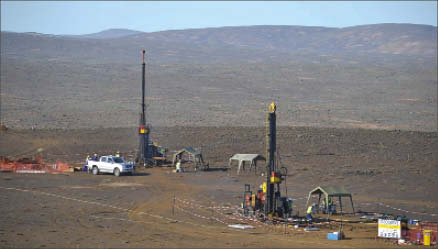A preliminary economic study (PEA) on Frontier Rare Earths’ (FRO-T) Zandkopsdrift rare earth element deposit in South Africa predicts that it could be a high-margin specialty minerals producer, churning out 20,000 tonnes of separated rare earth oxides per year over a 20-year mine life.
The study estimates capital costs at Zandkopsdrift, located 420 km north of Cape Town in Northern Cape Province, at US$910 million. That investment would fund an on-site concentrate plant, off-site rare earth separation plant and a 1-million-tonne-per-year open-pit operation. The PEA pegs the project’s after-tax net present value of US$3.65 billion at an 11% discount rate, and its internal rate of return at 52.5%. The payback period is estimated in two years, with production expected by July 2015.
Annual revenue is forecast at US$1.1 billion with an estimated 78% operating margin.
The study outlined a mining scenario that would focus on the Zandkopsdrift carbonatite deposit’s high-grade Central zone, with metallurgical recoveries estimated at 67%. An on-site plant would produce a high-purity mixed rare earth carbonate concentrate, which would be trucked 300 km to a rare earth separation plant located at Saldanha Bay, in Western Cape Province, where high-purity separated rare earth oxides (REOs) would be produced.
A rare earth oxide basket price of US$58.23 per kg was used, based on three-year China free-on-board prices and Roskill price forecasts for 2015. Operating costs are pegged at US$13.08 per kg of separated REOs.
A prefeasibility study on Zandkopsdrift is due by year-end, with full feasibility slated for 2013.
According to a 2011 resource estimate for Zandkopsdrift, the Central zone hosts 16 million indicated tonnes grading 3.09% for 495,060 tonnes total REO (TREO), plus inferred resources of 4.5 million tonnes grading 2.85% TREO for 129,160 tonnes TREO. A 2% TREO cut-off grade was used for the Central zone. The prefeasibility will look at the viability of mining lower-grade resources, including indicated resources of 32.4 million tonnes grading 2.28% TREO at a 1% TREO cut-off grade, plus 10.1 million inferred tonnes grading 2.08%.
However, Jon Hykawy, a mining analyst and head of global research at Byron Capital Markets, believes the rare earth pricing Frontier’s study relies on is too optimistic. In a note to clients, Hykawy states that when he plugs in his more conservative forecast REE prices, he comes up with a basket price of US$22.54 per kg, compared with US$58.23 used in the study, and a negative valuation for the project.
He was also disappointed with the predicted 4.2% concentrate grade, which he expected to be higher.
Hykawy, who has changed his rating of Frontier from a “buy” to a “hold,” still believes the project has potential to become a mine if a partner comes in that is willing to finance the solvent-extraction plant. The study estimates the plant will cost US$611 million.
Frontier has secured a partner in the form of Korea Resources (Kores) to help it advance the project. In December, the two parties signed a deal under which Kores will form a consortium that will acquire an initial 10% interest in Zandkopsdrift, now that a PEA has been completed. The price will be based on a predetermined formula that considers the valuation of Zandkopsdrift and Frontier’s direct 74% shareholding in the project through Sedex Minerals — Frontier has a 95% economic interest in the project — and the company’s enterprise value. The consortium can acquire another 10% of Zandkopsdrift and up to 10% interest in Frontier after a full feasibility for the project is released next year.
As part of the agreement, the consortium will enter into a long-term offtake agreement for up to 31% of production from Zandkopsdrift at market prices, and provide financial and technical assistance to Frontier. The parties will also look into forming downstream businesses together with metals, alloys and magnets.
Frontier shares closed more than 8% higher at $1.25 apiece on the news, after spiking as high as $1.34 during the day. The company has a 52-week trading range of 80¢ to $3.28, and 89.6 million shares outstanding.


Be the first to comment on "Frontier eyes 2015 start-up at Zandkopsdrift REE project"